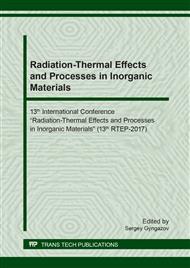p.165
p.170
p.176
p.185
p.190
p.195
p.200
p.206
p.211
Influence of Radiation Various Doses on Food Products and Feeds
Abstract:
Animal and plant products subjected to various doses of radiation were examined to measure the concentration of quinoid radiotoxins (QRTs) by the indirect hemagglutination (IHA) test using anantibody diagnosticum produced on the basis of immunoglobulin obtained through the hyperimmunization of sheep with a quinoid radiotoxin of plant origin. The irradiation of plant raw materials was performed in the "Issledovatel" gamma ray facility at a dose of 0.4 kGy. It has been found that the titers of radiotoxinsin the irradiated products depend on the type of product, the radiation dose as well as the length of the post-irradiation storage period. With the doses designated, in compliance with the technology, to extend the shelf life of potatoes and onions, the titer sranged from 1:8 to 1:74.7 in potatoes and from 1:10.7 to 1:85.3 in onions between days 3 and 30 after the radiation exposure. In the wheat and oats grains irradiated at doses of 0.3 and 0.7 kGy this indicator was 1:6.7-1:37.3. Between days 2 and 21 after the exposure to a dose of 25 kGy, QRT titers in the grainsranged from 1:21.3 to 1:53.3, against the titers of 1:0.7-1:2 in the non-irradiated grains. The titers of radiotoxins in the meat exposed to the doses of 10 and 20 kGy were 1:6.7-1:26.7 between days 3 and 30 after the radiation exposure. QRT levels in animal internal organs (liver) were greaterby 1-2 log2 than those in the meat. Elevated QRT levels in all of these irradiated products were recorded within the initial 45 days after the radiation exposure. On day 60, radiotoxin titers were at the same level as the control products.
Info:
Periodical:
Pages:
190-194
Citation:
Online since:
September 2018
Keywords:
Price:
Сopyright:
© 2018 Trans Tech Publications Ltd. All Rights Reserved
Share:
Citation:


